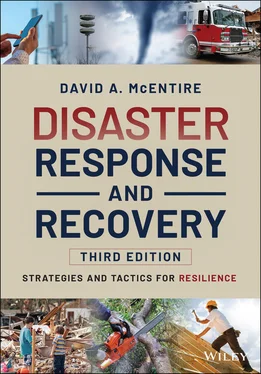David A. McEntire - Disaster Response and Recovery
Здесь есть возможность читать онлайн «David A. McEntire - Disaster Response and Recovery» — ознакомительный отрывок электронной книги совершенно бесплатно, а после прочтения отрывка купить полную версию. В некоторых случаях можно слушать аудио, скачать через торрент в формате fb2 и присутствует краткое содержание. Жанр: unrecognised, на английском языке. Описание произведения, (предисловие) а так же отзывы посетителей доступны на портале библиотеки ЛибКат.
- Название:Disaster Response and Recovery
- Автор:
- Жанр:
- Год:неизвестен
- ISBN:нет данных
- Рейтинг книги:5 / 5. Голосов: 1
-
Избранное:Добавить в избранное
- Отзывы:
-
Ваша оценка:
- 100
- 1
- 2
- 3
- 4
- 5
Disaster Response and Recovery: краткое содержание, описание и аннотация
Предлагаем к чтению аннотацию, описание, краткое содержание или предисловие (зависит от того, что написал сам автор книги «Disaster Response and Recovery»). Если вы не нашли необходимую информацию о книге — напишите в комментариях, мы постараемся отыскать её.
The new edition of the standard textbook in the field, updated with new studies and practical guidelines for reacting to the complexities of today’s disasters Disaster Response and Recovery: Strategies and Tactics for Resilience
Disaster Response and Recovery: Strategies and Tactics for Resilience, Third Edition
Disaster Response and Recovery — читать онлайн ознакомительный отрывок
Ниже представлен текст книги, разбитый по страницам. Система сохранения места последней прочитанной страницы, позволяет с удобством читать онлайн бесплатно книгу «Disaster Response and Recovery», без необходимости каждый раз заново искать на чём Вы остановились. Поставьте закладку, и сможете в любой момент перейти на страницу, на которой закончили чтение.
Интервал:
Закладка:
5 Jensen J. (2013, August 15) Report of the 2013 disciplinary purview focus group: scholarship and research to ground the emerging discipline of emergency management. Available at http://www.ndsu. edu/fileadmin/emgt/Jensen_‐013_REPORT_DISCPLINE_ISSUES_ WHITE_PAPER_FOCUS_GROUP 2_.pdf. Accessed June 27, 2014.
6 Kendra JM, Wachtendorf T. (2003) Reconsidering convergence and converger legitimacy in response to the World Trade Center disaster. In: Clarke L, editor. Terrorism and Disaster: New Threats, New Ideas. Research in Social Problems and Public Policy 11. New York: Elsevier. p 97–122.
7 McEntire DA. (2005) Revisiting the definition of ‘Hazard’ and the importance of reducing vulnerability. J Emerg Manag, 3 (4):9–11.
8 Mileti DS. (1999) Disasters by Design: A Reassessment of Natural Hazards in the United States. Washington, DC: Joseph Henry Press.
9 Ministry of the Interior. (2011) Red Sludge: Hungary 2010. Budapest: Ministry of the Interior.
10 Neal DM. (1997) Reconsidering the phases of disaster. Int J Mass Emerg Disasters, 15 (2):239–264.
11 Office of Homeland Security. (2002) National Strategy for Homeland Security. Washington, DC: Office of Homeland Security.
12 Perry RW. (1991) Managing disaster response operations. In: Drabek TE, Hoetmer GJ, editors. Emergency Management: Principles and Practice for Local Government. Washington, DC: ICMA. p 201–223.
13 Phillips BD, Neal DM, Webb GR. (2017) Introduction to Emergency Management. Second Edition. Boca Raton: CRC Press.
14 Quarantelli EL. (2006) Catastrophes are different than disasters: some implications or planning and management drawn from Hurricane Katrina. In: Understanding Katrina Perspectives from the Social Sciences. New York: Social Science Research Council.
15 UNISDR. (2013) Global assessment report on disaster risk reduction. Available at http://www.preventionweb.net/english/hyogo/gar/ 2013/en/home/index.html. Accessed on June 18, 2014.
2 Understanding the Actors: Roles and Responsibilities of Relevant Stakeholders
STARTING POINT
Pretest to assess your knowledge on roles and responsibilities of relevant stakeholders.
Determine where you need to concentrate your effort.
What You’ll Learn in This Chapter
Why many organizations are engaged after disasters.
The responsibilities of emergency management personnel.
The roles of major corporations and small businesses.
The activities of the nonprofit sector.
Anticipated citizen involvement in disasters.
How to work with different individuals and groups.
After Studying This Chapter, You’ll Be Able To
Compare the roles of the public and private sectors.
Differentiate duties of local, state, tribal and federal governments.
Convey how companies and businesses respond after disasters.
Examine the actions of non‐profit organizations.
Discuss how faith‐based organizations can assist disaster victims.
Describe emergent groups formation to meet disaster needs.
Goals and Outcomes
Predict the actions of the public, private and nonprofit sectors.
Evaluate the different types of services provided after disasters.
Assess who can help you fulfill response and recovery functions.
Analyze and overcome the challenges of coordination.
Employ the “whole community” concept in post‐disaster operations.
INTRODUCTION
After Hurricane Andrew devastated Miami Dade County in 1992, one local emergency manager asked, “Where the hell is the cavalry on this one?” This so‐called disaster “cavalry” includes many organizations and people. There are numerous agencies, groups and individuals involved in response and recovery operations. By understanding these stakeholders, you will be better able to harness their knowledge, skills and abilities after a disaster. These actors include organizations and persons from the public, private and nonprofit sectors. The public sectoris a segment of society that is made up of government departments, agencies and offices. Indian tribes may also be considered a segment of the public sector, although there are some significant differences between federal and tribal governments. The private sectoris the part of society that includes corporations and businesses. The nonprofit sectorof our communities is comprised of humanitarian, charitable, religious and voluntary organizations. Citizens also join in disaster response and recovery activities too. A typology created by scholars at the Disaster Research Center (DRC) may help you comprehend the difference among the many organizations that are involved in post‐disaster operations. Harnessing all of the participants described in this chapter will help you to promote disaster resilience.
2.1 The Public Sector
As an emergency manager, you should be aware of the many participants involved in disaster response and recovery operations. The aftermath of the April 20, 2010, British Petroleum (BP) Deepwater Horizon explosion/oil spill in the Gulf of Mexico provides a glimpse of this breadth and diversity. The first people on scene at the drilling platform were employees who helped to evacuate fellow colleagues, extracted those who had escaped the burning rig from the water below, and provided basic first aid to the injured. Helicopter crews from the Coast Guard took the most seriously injured victims to the hospital to receive treatment from medical personnel. Meanwhile, the media and government leaders provided updates to the public on the emergency while a number of engineers started to consider ways to cap the leaking well 5,000 feet below the ocean’s surface. Specialized companies started to skim the oil that was accumulating on top of the water and do what they could to protect marine animals and the natural habitat. The government launched an investigation while lawyers showed up to protect the rights of victims. Charitable organizations delivered relief to those who had lost their jobs in the fishing and tourism industries.
Other disasters have many similarities and differences as compared to the BP oil spill. A host of people and organizations become involved when different disasters occur and the list can be expected or quite surprising. In addition to those who are normally involved in disasters, participants may range from the American Library Association, Brethren Disaster Ministries, and the National Heritage Emergency Responders to leaders and employees of amusement parks, museums, the National Park Service, and school districts/universities. It is difficult to fully describe all of those who are or may be involved in a variety of functions during and after any incident or disaster. In fact, a disaster may have hundreds or thousands of participants who become involved in response and recovery operations.
Nonetheless, some of the most important participants in emergency management emanate from the public sector (McLoughlin 1985). As mentioned earlier, the public sector includes government entities at the local, county, state and federal levels as well as tribal nations. No two government jurisdictions operate or are organized alike. However, city personnel, county administrators, state agencies, federal officials and tribal groups all form part of the public sector.
2.1.1 Local Government
Local governments – whether towns, cities, or special districts ‐ are among the first official organizations to react to disasters from the public sector (McEntire 2006). Local governmentsare municipal organizations within county/parish jurisdictions that perform important public functions to address community‐wide response and recovery needs (Henstra 2010). In a disaster, these rely on emergency medical technicians (EMTs), paramedics, firefighters, police officers and emergency managers. Some of the EMTs may work for private companies and certain firefighters may volunteer for the departments they serve in rural communities. But, many of these individuals in the public sector are paid government employees—especially in larger, urban areas. Diverse departments and public leaders also play a role in response and recovery operations at the local level.
Читать дальшеИнтервал:
Закладка:
Похожие книги на «Disaster Response and Recovery»
Представляем Вашему вниманию похожие книги на «Disaster Response and Recovery» списком для выбора. Мы отобрали схожую по названию и смыслу литературу в надежде предоставить читателям больше вариантов отыскать новые, интересные, ещё непрочитанные произведения.
Обсуждение, отзывы о книге «Disaster Response and Recovery» и просто собственные мнения читателей. Оставьте ваши комментарии, напишите, что Вы думаете о произведении, его смысле или главных героях. Укажите что конкретно понравилось, а что нет, и почему Вы так считаете.












